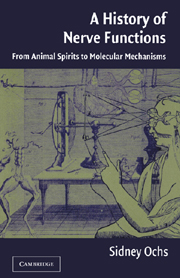Book contents
- Frontmatter
- Contents
- Preface
- 1 Introduction: Greek Science and the Recognition of Nerve as a Channel
- 2 Galen's Physiology of the Nervous System
- 3 Nerve, Brain, and Soul in the Middle Ages
- 4 Renaissance and the New Physiology
- 5 New Physical and Chemical Models of Nerve in the Enlightenment
- 6 New Systematizations of Nerve Function in the Enlightenment
- 7 Electricity as the Agent of Nerve Action
- 8 Nerve Fiber Form and Transformation
- 9 Wallerian Degeneration: Early and Late Phases
- 10 Nerve Regeneration
- 11 Characterization of Axoplasmic Transport
- 12 Molecular Models of Transport
- 13 Actions of Neurotoxins and Neuropathic Changes Related to Transport
- 14 Purposeful Reflexes and Instinctive Behavior
- 15 Neural Events Related to Learning and Memory
- 16 Epilogue: With Observations on the Relation of the Nervous System to Mind
- Bibliography
- Index
16 - Epilogue: With Observations on the Relation of the Nervous System to Mind
Published online by Cambridge University Press: 13 August 2009
- Frontmatter
- Contents
- Preface
- 1 Introduction: Greek Science and the Recognition of Nerve as a Channel
- 2 Galen's Physiology of the Nervous System
- 3 Nerve, Brain, and Soul in the Middle Ages
- 4 Renaissance and the New Physiology
- 5 New Physical and Chemical Models of Nerve in the Enlightenment
- 6 New Systematizations of Nerve Function in the Enlightenment
- 7 Electricity as the Agent of Nerve Action
- 8 Nerve Fiber Form and Transformation
- 9 Wallerian Degeneration: Early and Late Phases
- 10 Nerve Regeneration
- 11 Characterization of Axoplasmic Transport
- 12 Molecular Models of Transport
- 13 Actions of Neurotoxins and Neuropathic Changes Related to Transport
- 14 Purposeful Reflexes and Instinctive Behavior
- 15 Neural Events Related to Learning and Memory
- 16 Epilogue: With Observations on the Relation of the Nervous System to Mind
- Bibliography
- Index
Summary
Our aim in this chapter is to consider how what we now know of the nervous system may account for understanding human behavior. Rather than the early view of animal spirits and surrogates for them, our view of the nervous system is that it is composed of neurons, with a mechanism of axoplasmic transport in them as schematized for a peripheral neuron in Figure 16.1. The same axonal mechanism is present as well in all neurons in the central nervous system. An example is that of cortical neurons crossing from one hemisphere to the other via the callosal tract. In addition to components required to maintain the viability of fibers and to provide the neurotransmitters acting at synaptic junctions. Other molecular signals are transported between neurons to establish and maintain the networks responsible for the integrated behavior of the organism. Networks formed in the brain under genetic control are responsible for perception, cognition and memory and are not permanently fixed. They are modified in the course of learning (Chapter 15). The broader theoretical issues relate to the degree of innateness of sensory and perceptual processes and how change is brought about.
Up through most of the latter century, the concept of reflexes was held as the key to understanding behavior. In his great book on reflexes of the nervous system, Sherrington wrote,
The reflex-arc is the unit mechanism of the nervous system when that system is regarded in its integrative function. The unit reaction in nervous integration is the reflex, because every reflex is an integrative action and no nervous action short of a reflex is a complete act of integration. […]
Information
- Type
- Chapter
- Information
- A History of Nerve FunctionsFrom Animal Spirits to Molecular Mechanisms, pp. 353 - 366Publisher: Cambridge University PressPrint publication year: 2004
